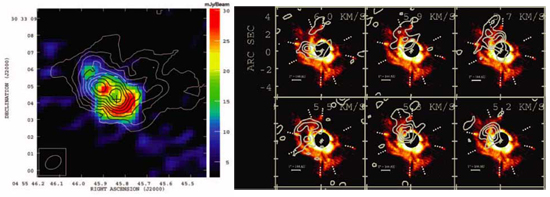Research Gallery > Star Formation Studies
Research Gallery
Star Formation Studies
| Protoplanetary disk around AB Aurigae |
|
Image Credit: Lin et al.

Protoplanetary disk around AB Aurigae. Left: A comparison between the 0.85 mm dust continuum emission (color) and the CO(3-2) emission (contours) from the disk. Right: The CO(3-2) emission shown in the velocity channels from VLSR = 5.2 to 6.0 km/s superpo
|
| AB Aurigae is one of the brightest Herbig Ae stars (intermediate-mass pre-main-sequence stars) located 144 pc (~470 light years) away from the Sun, The near infrared image taken by the Subaru telescope shows a spiral pattern in the disk. We have observed the dust continuum emission and the CO(3-2) emission line with the SMA at an angular resolution of 1" (= 144 AU). The dust disk shown in the color of the left panel exhibits a central hole, which is possibly indicative of grain growth phenomenon due to planetesimal formation. The CO emission traces a gas disk in rotation, which departs noticeably from Keplerian; there is an outward radial motion along the spiral arm in the disk. The results suggest that there may be a giant (Jupiter-sized) planet forming inside the circumstellar disk of AB Aur responsible for the perturbation in morphology and kinematics. |
 asiaa.sinica.edu.tw Media Request: epo
asiaa.sinica.edu.tw Media Request: epo asiaa.sinica.edu.tw
asiaa.sinica.edu.tw 
